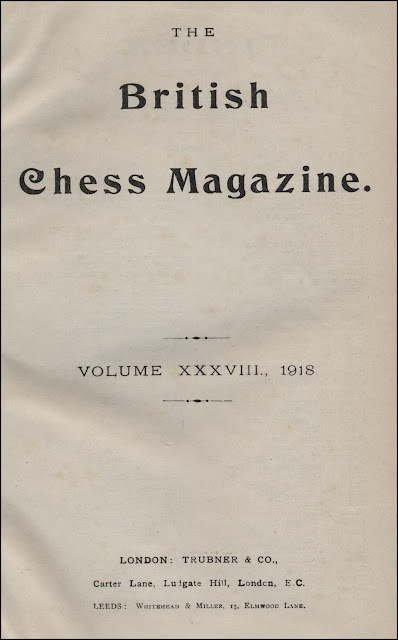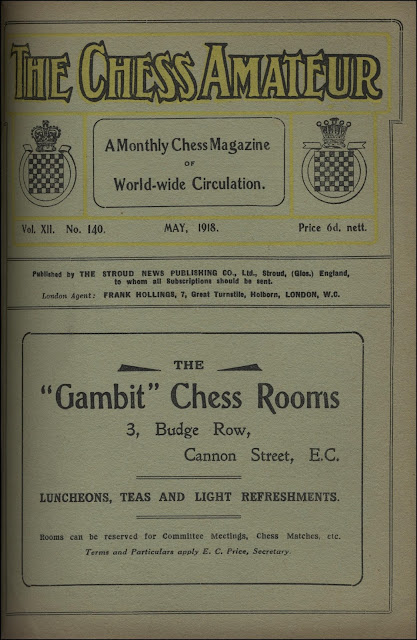1918 saw the end of The Great War during which, it seems, chess book publishing virtually ground to a halt. I can find only five new chess books published in English in 1918. I have not checked extensively for non-English works but, judging by the lack of book reviews in the main chess periodicals of the time, they were also thin on the ground. (Bernhard Kagan published pamphlets in 1918 on the two Berlin tournaments held that year and another on the match between Rubinstein and Schlechter also held in Berlin in 1918, and a pamphlet was published in 1918 by Curt Ronniger on the Kaschau International Tournament held in August 1918.)
The five works in English were as follows:
1. The International Chess Code, by The British Chess Company, published by Routledge, London and Dutton, New York.
Not entirely new, but considerably enlarged, and with a new title, compared with previous editions. Page 9 of The Chess Amateur for October 1918 carried an article by E. E. Cunnington, the co-author with W. Moffatt, outlining the evolution of their Chess Code, which was first published in 1894, and the great lengths they went to, along with W. P. Turnbull, in preparing this work.
However, both The Chess Amateur and The British Chess Magazine published decidedly critical reviews of this book, claiming that it was unnecessary and carried little weight, as the generally accepted laws of the game had been published by the British Chess Federation in 1912. The review in The Chess Amateur is on page 2 of the October 1918 issue and is taken from Times Weekly. The unsigned BCM review, probably by the editor I. M. Brown, is on page 295 of the October 1918 issue.
 |
| BCM October 1918 page 295 |
_____________________________________
2. Chess and Checkers: The Way to Mastership, by Edward Lasker, New York and London.
This is a more elementary treatise than Lasker's previous work Chess Strategy, first published in English in 1915. The chess section takes up 222 of the 284 pages and includes chapters on The Rules of the Game, Elementary Tactics, General Principles of Chess Strategy, and two Illustrative Games, annotated at length; a win by the author against Jackson Showalter and a loss to Capablanca. Finally a chapter on Problems outlines the art of problem composition with a few examples.
 |
| Title page from 1929 reprint |
In his Introduction, Edward Lasker lists 16 leading players of the day in approximate order of strength, a matter picked up by The British Chess Magazine when reviewing this book on pages 110-111 of the April 1919 issue. The BCM berated Lasker for omitting Blackburne, Atkins and Gunsberg from the list of players of international fame. However, by 1918, Blackburne and Gunsberg, if not Atkins, were surely past their best.
3. Chess Idylls: A Collection of Problems by Godfrey Heathcote, edited by Murray Marble, Alain C. White and George Hume, published by The Chess Amateur, Stroud.
Alain C. White had "hearkened to the call of his nation's exigencies and was engaged on national duties" (BCM February 1918 page 45), but, nevertheless, was able to continue with his annual Christmas Series productions, and devoted this volume to the compositions of England's foremost composer Godfrey Heathcote.
 |
| Godfrey Heathcote from page 100 of The Chess Bouquet |
Although persistently advertised as Alain C. White's 1919 book in The Chess Amateur, this was in fact issued to recipients in time for Christmas 1918.
Heathcote and White were highly praised for their respective endeavours, in long reviews of Chess Idylls in both The British Chess Magazine (February 1919 page 59, and May 1919 page 178), and The Chess Amateur (February 1919 pages 134, 136 and 137-138).
 | |
| BCM February 1919, page 59 |
________________________________
4. Seventy-two black-checkers, by C. D. Locock, published by Whitehead and Miller, Leeds.
This scarce eleven page pamphlet brings together four articles published in the BCM in September to December 1917 dealing with complex problems described as "synthetic self-mates in which White does not check or capture, and Black does not move except to check".
Finally, here's one you haven't got:
5. History of Chess in Queensland, by W. A. Smith, Brisbane.
According to The Chess Literature of Australia and New Zealand, 4th Edition, by John van Manen, Belgrade 2011, this history of the Queensland Chess Association was compiled by its secretary, W. A. Smith, and read at a meeting of the Association in January 1918. The lecture was subsequently printed and a copy sent to every member.
___________________________________
So, putting aside the revised book of rules, Locock's weird pamphlet and the talk on Queensland chess, there were just two chess books of substance published in English in 1918; Edward Lasker's book for beginners and Alain C. White's annual offering of problems. This seems quite extraordinary compared with the torrent of chess literature in recent years.
________________________________
So, putting aside the revised book of rules, Locock's weird pamphlet and the talk on Queensland chess, there were just two chess books of substance published in English in 1918; Edward Lasker's book for beginners and Alain C. White's annual offering of problems. This seems quite extraordinary compared with the torrent of chess literature in recent years.
________________________________
With this paucity of new chess literature it was largely left to the chess periodicals and chess columns to keep the flag flying and to provide regular sustenance for chess enthusiasts. In America, the American Chess Bulletin and The Good Companion Chess Problem Club were both produced throughout the war, while in England, The British Chess Magazine, The Chess Amateur and the British Correspondence Chess Association Magazine were published continuously at this time. However, this was not without considerable difficulties due to the lack of chess material, interrupted postal services, paper shortages and increased costs etc.
 |
| The Chess Amateur, advert January 1918 |
One periodical was actually launched in 1918; The British Columbia Chess Magazine (later The Canadian Chess Magazine, Betts 7-61, Chess Periodicals 427), the first copy of which was published in December 1918.
The Chess Amateur for March 1918 included this Blackburne Bon-Mot on page 162:
© Michael Clapham 2018












No comments:
Post a Comment